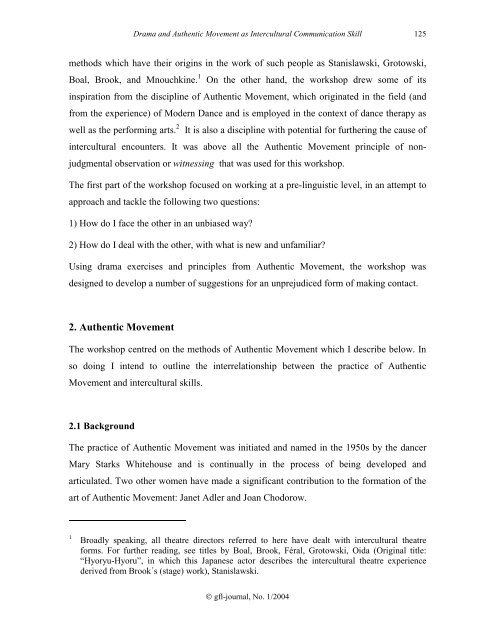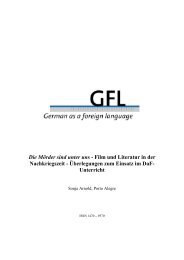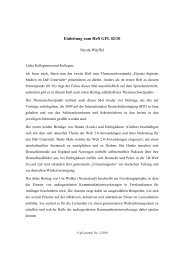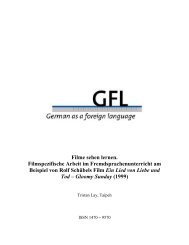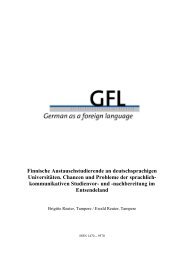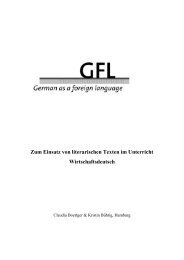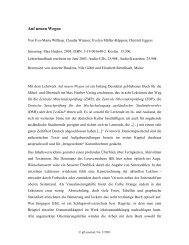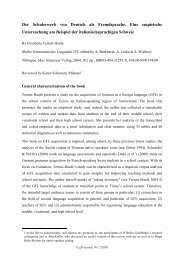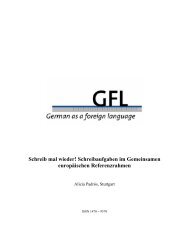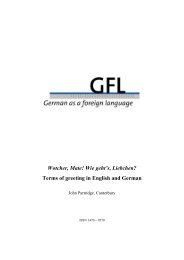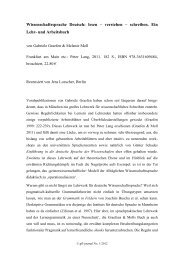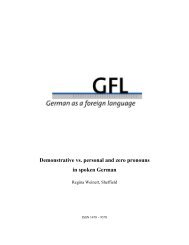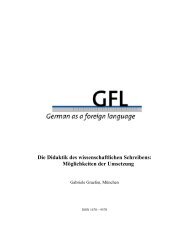Drama and Authentic Movement as Intercultural ... - GFL
Drama and Authentic Movement as Intercultural ... - GFL
Drama and Authentic Movement as Intercultural ... - GFL
You also want an ePaper? Increase the reach of your titles
YUMPU automatically turns print PDFs into web optimized ePapers that Google loves.
<strong>Drama</strong> <strong>and</strong> <strong>Authentic</strong> <strong>Movement</strong> <strong>as</strong> <strong>Intercultural</strong> Communication Skill<br />
125<br />
methods which have their origins in the work of such people <strong>as</strong> Stanislawski, Grotowski,<br />
Boal, Brook, <strong>and</strong> Mnouchkine. 1 On the other h<strong>and</strong>, the workshop drew some of its<br />
inspiration from the discipline of <strong>Authentic</strong> <strong>Movement</strong>, which originated in the field (<strong>and</strong><br />
from the experience) of Modern Dance <strong>and</strong> is employed in the context of dance therapy <strong>as</strong><br />
well <strong>as</strong> the performing arts. 2 It is also a discipline with potential for furthering the cause of<br />
intercultural encounters. It w<strong>as</strong> above all the <strong>Authentic</strong> <strong>Movement</strong> principle of nonjudgmental<br />
observation or witnessing that w<strong>as</strong> used for this workshop.<br />
The first part of the workshop focused on working at a pre-linguistic level, in an attempt to<br />
approach <strong>and</strong> tackle the following two questions:<br />
1) How do I face the other in an unbi<strong>as</strong>ed way?<br />
2) How do I deal with the other, with what is new <strong>and</strong> unfamiliar?<br />
Using drama exercises <strong>and</strong> principles from <strong>Authentic</strong> <strong>Movement</strong>, the workshop w<strong>as</strong><br />
designed to develop a number of suggestions for an unprejudiced form of making contact.<br />
2. <strong>Authentic</strong> <strong>Movement</strong><br />
The workshop centred on the methods of <strong>Authentic</strong> <strong>Movement</strong> which I describe below. In<br />
so doing I intend to outline the interrelationship between the practice of <strong>Authentic</strong><br />
<strong>Movement</strong> <strong>and</strong> intercultural skills.<br />
2.1 Background<br />
The practice of <strong>Authentic</strong> <strong>Movement</strong> w<strong>as</strong> initiated <strong>and</strong> named in the 1950s by the dancer<br />
Mary Starks Whitehouse <strong>and</strong> is continually in the process of being developed <strong>and</strong><br />
articulated. Two other women have made a significant contribution to the formation of the<br />
art of <strong>Authentic</strong> <strong>Movement</strong>: Janet Adler <strong>and</strong> Joan Chodorow.<br />
1<br />
Broadly speaking, all theatre directors referred to here have dealt with intercultural theatre<br />
forms. For further reading, see titles by Boal, Brook, Féral, Grotowski, Oida (Original title:<br />
“Hyoryu-Hyoru”, in which this Japanese actor describes the intercultural theatre experience<br />
derived from Brook´s (stage) work), Stanislawski.<br />
© gfl-journal, No. 1/2004


